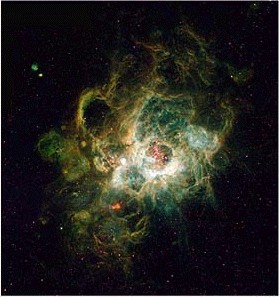Please contact me what other SEDS Deep Sky Links you'd like to see here !
A Guide to the Deepsky Astronomy Resources at SEDS
 Beyond the asymptotic emptiness surrounding our Solar System up to a few light
years distance begins the domain of other stars, clusters, and nebulae of our
Galaxy, the Milky Way, and beyond it, the world of galaxies. This domain beyond
our Solar System is often summarized as Deep Sky or Deep Space.
Classifying astronomy for the objects under investigation, it is the second big
branch of astronomy, besides the sciences of the Solar System.
A very good internet resource on the Solar System, also hosted at SEDS,
is Bill Arnett's
Nine Planets Multimedia Tour.
Here we want to give a brief guide to the various Deep Sky Resources at
SEDS.
Beyond the asymptotic emptiness surrounding our Solar System up to a few light
years distance begins the domain of other stars, clusters, and nebulae of our
Galaxy, the Milky Way, and beyond it, the world of galaxies. This domain beyond
our Solar System is often summarized as Deep Sky or Deep Space.
Classifying astronomy for the objects under investigation, it is the second big
branch of astronomy, besides the sciences of the Solar System.
A very good internet resource on the Solar System, also hosted at SEDS,
is Bill Arnett's
Nine Planets Multimedia Tour.
Here we want to give a brief guide to the various Deep Sky Resources at
SEDS.
Deep Sky Objects in a closer sense are those nebulous patches which can be
seen in the sky and are not individual single or multiple stars:
Star clusters,
gaseous (and dusty)
nebulae, and
galaxies.
It is for historical and observational reasons that these very different
objects are summarized in one category. Overall, they are among the more
conspicuous and delightful objects to observe, photograph, and study for
astronomers.
Our image was obtained by the
Hubble Space Telescope
and shows the giant diffuse nebula and star cluster
NGC 604 in the
Triangulum Galaxy M33 which is a member of
the Local Group of galaxies, like our own
Milky Way Galaxy. It is about 3 million
light years distant.
The following resources at SEDS are related to Deep Sky Objects:
- SEDS Messier Catalog database
maintained by
Hartmut Frommert. A comprehensive guide
to the Messier objects, and all kinds of related stuff.
- Messier Object Photolist
with images
or in text only form
- Messier Object images
from the Digital Sky Survey,
collected by Bill Arnett
- Messier Marathon Homepage
- The Web Nebula,
collection of images of gaseous nebulae, by
Bill Arnett
- NGC online:
An interactive NGC (and IC, Messier) catalog by
Hartmut Frommert
- GCO images of Deep
Sky Objects, collected by Steve Williams and maintained by
Bill Arnett
- SEDS Guide to the Hubble Space
Telescope images, by Mark Elowitz and Guy McArthur
- Constellations and Stars by
Christine Kronberg
gives information and background material, including general
information, stars, deepsky objects and meteor showers, together with
the best available constellation maps. Some material on stars is also
linked.
- Astromaps by
Christine Kronberg
shows photographic star maps for the whole night sky, sorteded by
season,
-
List of Common Names for Deep Sky Objects by
Hartmut Frommert
-
History of the Discovery of the Deep Sky Objects by
Hartmut Frommert
-
Collection of Deep Sky Catalogs and Observing Lists by
Hartmut Frommert
- SEDS FTP astronomy and space
image archive;
deep sky images;
HST images
![[Deepsky Home]](../Jco/n0604ico.jpg) This icon brings you back to this SEDS Deep Sky Homepage
This icon brings you back to this SEDS Deep Sky Homepage
Please contact me what other SEDS Deep Sky Links you'd like to see here !
Hartmut Frommert
[contact]
![[SEDS]](../Jco/seds50.jpg)
![[SEDS]](../Jco/seds50.jpg)
 Beyond the asymptotic emptiness surrounding our Solar System up to a few light
years distance begins the domain of other stars, clusters, and nebulae of our
Galaxy, the Milky Way, and beyond it, the world of galaxies. This domain beyond
our Solar System is often summarized as Deep Sky or Deep Space.
Classifying astronomy for the objects under investigation, it is the second big
branch of astronomy, besides the sciences of the Solar System.
A very good internet resource on the Solar System, also hosted at SEDS,
is Bill Arnett's
Nine Planets Multimedia Tour.
Here we want to give a brief guide to the various Deep Sky Resources at
SEDS.
Beyond the asymptotic emptiness surrounding our Solar System up to a few light
years distance begins the domain of other stars, clusters, and nebulae of our
Galaxy, the Milky Way, and beyond it, the world of galaxies. This domain beyond
our Solar System is often summarized as Deep Sky or Deep Space.
Classifying astronomy for the objects under investigation, it is the second big
branch of astronomy, besides the sciences of the Solar System.
A very good internet resource on the Solar System, also hosted at SEDS,
is Bill Arnett's
Nine Planets Multimedia Tour.
Here we want to give a brief guide to the various Deep Sky Resources at
SEDS.
![[Deepsky Home]](../Jco/n0604ico.jpg) This icon brings you back to this SEDS Deep Sky Homepage
This icon brings you back to this SEDS Deep Sky Homepage